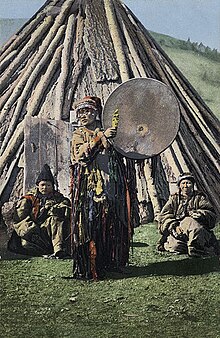腾格里信仰

腾格里信仰是突厥人、蒙古人、匈人和匈奴等中亚游牧民族的传统信仰[1],带有萨满教、泛灵信仰、图腾崇拜和祖先崇拜色彩。腾格里信仰以一神论思想为主[2][3],崇拜中心神灵腾格里(突厥语:𐱅𐰭𐰼𐰃 ẗŋr̈y→täŋri、täŋäri或täŋiri;保加利亞語:Тангра Tangra;土耳其語:Tanrı;蒙古语:ᠲᠩᠷᠢ Tngri;達斡爾語:tangar /təŋgər/[4];哈萨克语:تاڭىر Тәңір 回鶻語:![]() /tängri/;維吾爾語:تەڭرى tengri[5])。后由于受到佛教、印度教等影响,腾格里被加上各种称呼,分裂成为众多神灵,17世纪后甚至出现“九十九腾格里”的说法,有学者因而称之为“一神论和多神论的结合”[6]。在欧洲,可萨人、保加尔人、马扎尔人[7]和阿瓦尔人也曾信仰腾格里[8]。腾格里信仰也是历史上突厥汗国、西突厥汗国、旧大保加利亚和保加利亚第一帝国的主要宗教。
/tängri/;維吾爾語:تەڭرى tengri[5])。后由于受到佛教、印度教等影响,腾格里被加上各种称呼,分裂成为众多神灵,17世纪后甚至出现“九十九腾格里”的说法,有学者因而称之为“一神论和多神论的结合”[6]。在欧洲,可萨人、保加尔人、马扎尔人[7]和阿瓦尔人也曾信仰腾格里[8]。腾格里信仰也是历史上突厥汗国、西突厥汗国、旧大保加利亚和保加利亚第一帝国的主要宗教。
“腾格里”一词最早出于匈奴,在中国古代典籍中,写作“撑犁”[9][10]。“腾格里”,是古代中亚游牧民族对于天的称呼,与突厥同族的敕勒发展出了“苍天”(Koke Tengri;蒙古语:Khukh Tengri)的概念[11],而蒙古人将蒙哥·腾格里(突厥语:Mangu Tangri;蒙古语:Mongke Tangri,汉语译作长生天)作为最高信仰。现代土耳其语也称腾格里信仰为“Göktanrı dini”,意为“天神教”,语源是蒙古语的“Khukh Tengri”,即“苍天”[12]。
腾格里信仰认为人的存在由“长生天”腾格里和大地母亲Umay维持,人需要诚实、有敬畏心地生活以调和自己的世界,并使自身的灵魂变得更为完美[1]。
腾格里信仰在其各信众部族中逐渐被伊斯兰教、藏传佛教、摩尼教[13]和基督教等强势宗教取代,但自20世纪90年代起苏联解体起,中亚新建立的突厥语族共和国又开始重新推崇这种传统信仰[14][15],在俄罗斯西伯利亚的萨哈共和国、鞑靼斯坦共和国、布里亚特共和国和图瓦共和国等地也有复苏迹象,但不与既有信仰冲突[16]。吉尔吉斯共和国的前政府成员達斯坦·薩里古洛夫成立了“腾格里军”(Tengir Ordo),旨在宣传腾格里信仰的传统价值;他还领导有一个声称有50万名信众的腾格里社群,支持国际腾格里信仰的研究[17]。
蒙古薩滿信仰(蒙古语:Бөө мөргөл Böö mörgöl)以腾格里信仰为核心,也常常被直接称为“腾格里信仰”或“腾格里教”(Tengrism)[18][19]。
参见
[编辑]参考文献
[编辑]- ^ 1.0 1.1 Rona-Tas, Andras; András, Róna-Tas. Hungarians and Europe in the Early Middle Ages: An Introduction to Early Hungarian History. Central European University Press. 1999-03: 151 [2020-08-24]. ISBN 978-963-9116-48-1. (原始内容存档于2020-09-22) (英语).
There is no doubt that between the 6th and 9th centuries Tengrism was the religion among the nomads of the steppes
- ^ The spelling Tengrism is found in the 1960s, e.g. Bergounioux (ed.), Primitive and prehistoric religions, Volume 140, Hawthorn Books, 1966, p. 80. Tengrianism is a reflection of the Russian term, Тенгрианство. It is reported in 1996 ("so-called Tengrianism") in Shnirelʹman (ed.), Who gets the past?: competition for ancestors among non-Russian intellectuals in Russia, Woodrow Wilson Center Press, 1996, ISBN 978-0-8018-5221-3, p. 31 in the context of the nationalist rivalry over Bulgar legacy. The spellings Tengriism and Tengrianity are later, reported (deprecatingly, in scare quotes) in 2004 in Central Asiatic journal, vol. 48–49 (2004), p. 238. The Turkish term Tengricilik is also found from the 1990s. Mongolian Тэнгэр шүтлэг is used in a 1999 biography of Genghis Khan (Boldbaatar et. al, Чингис хаан, 1162-1227, Хаадын сан, 1999, p. 18).
- ^ R. Meserve, Religions in the central Asian environment. In: History of Civilizations of Central Asia, Volume IV (页面存档备份,存于互联网档案馆), The age of achievement: A.D. 750 to the end of the fifteenth century, Part Two: The achievements, p. 68:
- "[...] The ‘imperial’ religion was more monotheistic, centred around the all-powerful god Tengri, the sky god."
- ^ Barbara Kellner-Heinkele; Brigitte Heuer; Elena V. Boykova. Man and Nature in the Altaic World. 2006 [2021-06-19]. (原始内容存档于2021-06-29).
- ^ How to pronounce تەڭرى. [2021-06-19]. (原始内容存档于2021-06-28).
- ^ Fergus, Michael; Jandosova, Janar. Kazakhstan: Coming of Age. Stacey International. 2003: 91 [2020-08-24]. ISBN 978-1-900988-61-2. (原始内容存档于2020-09-23) (英语).
[...] a profound combination of monotheism and polytheism that has come to be known as Tengrism.
- ^ Fodor István, A magyarok ősi vallásáról (About the old religion of the Hungarians) (页面存档备份,存于互联网档案馆) Vallástudományi Tanulmányok. 6/2004, Budapest, p. 17–19
- ^ McGuckin, John Anthony. The Encyclopedia of Eastern Orthodox Christianity. John Wiley & Sons. 2010-12-15: 79 [2020-08-24]. ISBN 978-1-4443-9254-8. (原始内容存档于2020-07-01) (英语).
- ^ 《汉书·匈奴传》:“匈奴谓天为撑犁。”
- ^ 《册府元龟·300》:“撑音田庾切。”
- ^ 《敕勒歌》:“天苍苍,野茫茫”。
- ^ Eröz, Mehmet. Eski Türk dini (gök tanrı inancı) ve Alevîlik-Bektaşilik. Türk Dünyası Araştırmaları Vakfı. 1992 [2020-08-24]. ISBN 978-975-498-051-6. (原始内容存档于2020-08-11) (土耳其语).
- ^ Buddhist studies review, Volumes 6-8, 1989, p. 164.
- ^ Saunders, Robert A. and Vlad Strukov. Historical Dictionary of the Russian Federation. Lanham, MD: Scarecrow Press. 2010: 412–13. ISBN 978-0-81085475-8.
- ^ Saunders, Robert A.; Strukov, Vlad. Historical Dictionary of the Russian Federation. Scarecrow Press. 2010-05-13: 412–413 [2020-08-24]. ISBN 978-0-8108-7460-2. (原始内容存档于2020-09-13) (英语).
- ^ Balkanlar'dan Uluğ Türkistan'a Türk halk inançları Cilt 1, Yaşar Kalafat, Berikan, 2007
- ^ McDermott, Roger. High-Ranking Kyrgyz Official Proposes New National Ideology. The Jamestown Foundation. [2013-02-19]. (原始内容存档于2012-09-12).
- ^ Walther Heissig. The Religions of Mongolia. Routledge, 2000. ISBN 0710306857. P. 46
- ^ Michael Stausberg. Religion and Tourism: Crossroads, Destinations and Encounters. Routledge, 2010 (ISBN 0415549329), p.162: «Julie Steward, alias Sarangerel Odigon (1963-2006), a woman with a Mongolian (Buryat) mother and a German father, born in the United States, started to practice shamanism (or what she would refer to as "Tengerism") as an adult; she then moved to Mongolia where she strived to restore and reconstruct the "ancient and original" religion of the Mongolians. Among her major moves was the founding of a Mongolian Shamans' Association (Golomt Tuv) which gave Mongolian shamans a common platform and brought them into touch with shamans in other parts of the world, with the prospect of starting a shamanic world organization. Through some books Sarangerel also spread her Mongolian message to Western audiences. She traveled widely, giving lectures and holding workshops on Mongolian shamanism. Moreover, she started a Mongolian shamanic association of America (the Circle of Tengerism).»
- ^ A. S. Amanjolov, History of ancient Türkic Script, Almaty 2003, p.305
书目
[编辑]- Brent, Peter. The Mongol Empire: Genghis Khan: His Triumph and his Legacy. London: Book Club Associates. 1976.
- Richtsfeld, Bruno J. Rezente ostmongolische Schöpfungs-, Ursprungs- und Weltkatastrophenerzählungen und ihre innerasiatischen Motiv- und Sujetparallelen. Münchner Beiträge zur Völkerkunde. Jahrbuch des Staatlichen Museums für Völkerkunde München 9. 2004: 225–274.
